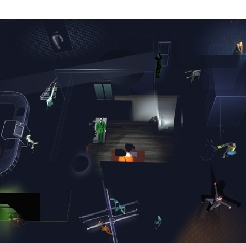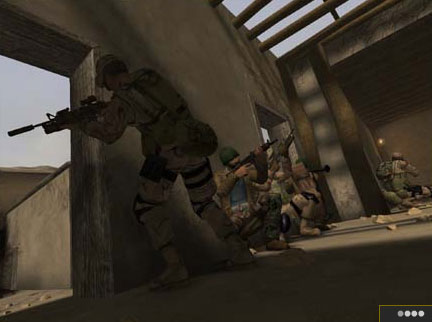
 |
review
exhibition |
Bang
the Machine:
Computer Gaming Art and Artifacts @ Yerba Buena Center for the Arts by Adam Chapman Adam@AdamChapmanArt.com
|
Exhibition
URL: http://www.yerbabuenaarts.org/va/current/bang_mach.html
Presented
in conjunction with the Stanford Humanities Laboratory and the Cantor
Center for Visual Arts at Stanford University (http://www.stanford.edu/dept/SUMA) |
I've seen a good number of shows dealing with games and game art, so I was expecting a fairly run-of-the-mill fun, but not terribly enlightening show. Happily, though, I was surprised. The show itself featured game mods, work inspired by the game aesthetics, and original games. |
Highlights
included… Game Mods:
The most noteworthy game mod was Waco Resurrection by the art collective C-Level. It's a traditional First Person Shooter type of game, but it all takes place as the ATF is storming the Branch Davidian compound. As rockets fall from the sky and snipers swarm into the meeting hall, it is your job (as David Koresh himself) to run around and convert or thwart the ATF foot soldiers. What's more, to get the full game experience you must don a Koresh mask with microphone (the microphone recognizes voice commands which are necessary to perform any of the spells). You can stun the agents with your charisma and lead them into the chapel (to convert them) or call out other spells to create a magic circle which levels those around you. (http://waco.c-level.org) Pain
Station, by Volker Morawe and Tilman Reiff, reintroduces
physical consequence into game play. As the user plays a Pong-type
game, they are given electric shocks (and are occasionally whipped
on their hands) when they miss. The game was not in operation while
I was there, but the video displayed smiling, cringing participants.
The idea of introducing physical consequence to actions in a virtual
world is clever and fun, but tying the physical to such a simple
game is, perhaps, not worthy of lengthy analysis. Still, I couldn't
help thinking of the scene in Never Say Never Again where James Bond and his nemesis are playing
a video game, World Domination, and receive stronger electric shocks
when they lose a country. (http://www.painstation.de)
Another game (Janek Simon's Carpet Invaders) was basically Space Invaders taking the shape of Afghan rug patterns on an Afghan rug background. The piece was interesting partially because it was projected onto the floor, creating a seemingly living rug, and partially because it addressed the idea of the current two-front Mid-East conflict in a more poetic manner. It's unfortunate that the game play didn't really advance the aesthetic message, but the elegance of the statement itself was nice to see. |
|
Work
inspired by games:
Also
featured was Paul Kaiser's and Shelley Eskar's latest piece, Arrival, a mesmerizing
animation that uses the isometric visual style so often found in
video games. Characters move forward and backward through time,
going through the minutia of busywork, theft, espionage, and travel.
As characters perform their actions, a spotlight view of their world
comes into view. As they complete their action, the spotlight --
and consequently the view of their world -- fades out and they disappear.
Arrival takes
on the familiar eye-in-the-sky perspective (as did the artists'
previous work, Pedestrian), however, there is no unified "ground."
The characters and scenes all operate on different "levels,"
creating a magical Escher-like world where walls and floors are
not what they seem.
For
the first time, Eskar and Kaiser have provided some level of interactivity:
a dial that allows you to control the movement of the video (forward
or backward). The idea is to put the viewer in the position of
a security professional who might have to "scrub" the
tape to illicit finer data, but because the video is already composed
of scenes which move forward and backward, the interaction feels
superfluous and somewhat distracting. In the end, the piece is
about surveillance, where the audience is put in the position
of the voyeur. However, you aren't watching the mind-numbing minutia
of daily life but a world populated by characters whose every
motion is finely choreographed and elegant. Kaiser and Eskar create
a hypnotic world in which you lose yourself. (http://www.kaiserworks.com)
|
 Kaiser & Eskar's Arrival |
C-Level
collective member Brody Condon's 650 Polygon John Carmack sculpture
is also noteworthy. It is, literally, a 650 polygon representation
of the Id Software (Doom, Castle Wolfenstein) mogul, realized in milled foam, resin, and laser
prints; and standing about 3 feet tall. Its simplicity and congruency
of idea and form is as remarkable as it is humorous and playful.
(http: //www.tmpspace.com/carmack.html)
New Games: All
of the above projects stood out for specific reasons, but the most
notable aspect of the show was the inclusion of an America's Army installation.
The installation featured 4 arcade-style consoles, a simulation
of a stone wall similar to the walls in the game, and a video on
the making of the game.
America's
Army is, according to their own site, part of
the Army's communications strategy designed to leverage the power
of the Internet as a portal through which young adults can get a
first hand look at what it is like to be a Soldier. The game introduces
players to different Army schools, Army training, and life in the
Army. Given the popularity of computer games and the ability of
the Internet to deliver great content, a game was the perfect venue
for highlighting different aspects of the Army.
The
creative team modeled the environment after actual battle zones,
did extensive interviews and testing with military personnel, and
made characters out of actual soldiers. In this installation, you
can't fire a gun (thus missing out on the most popular role assumed
by players, the Sniper), but you can command and communicate with
other soldiers. |
|
|
America's
Army is the most profound incarnation of all
of the concerns that come with any FPS or military simulation.
I heard that the makers of the game found it validating for
AA to be featured in an art show. However, given the context
in which the project was shown (i.e., the nature of the games
that surround it), it's hard not to think of AA's inclusion
as an exposure of the dark underbelly of the game industry and
the insidious possibilities and realities of the technologies
employed in game design and development. As such, it was utterly
refreshing to see this subject addressed not by a work, but
by the curators. AA is presented without the overt hand of the
curator (i.e., there is no curatorial statement describing the
reasons for the inclusion of the project), and so it could,
conceivably, be read as a recognition of the massive amounts
of money and work dedicated to the game. However, given the
context in which AA is featured, this viewer found it impossible
to see the project in a non-critical light. Indeed, several
gallery patrons expressed shock at the presence and existence
of the project. As I watched the video on the making of the
game and then played the game itself, I felt both disturbed
and disgusted. (http: //www.americasarmy.com)
All
in all, the curators did a great job representing the breadth
of work being done with and around games and gaming culture.
What's more, they actually tackled some of the more difficult
issues surrounding the gaming industry at large.
|
America's
Army is
the most profound incarnation of all of the concerns that come with
any FPS or military simulation. I heard that the makers of the game
found it validating for AA to be featured in an art show. However,
given the context in which the project was shown (i.e., the nature
of the games that surround it), it's hard not to think of AA's inclusion
as an exposure of the dark underbelly of the game industry and the
insidious possibilities and realities of the technologies employed
in game design and development.  |